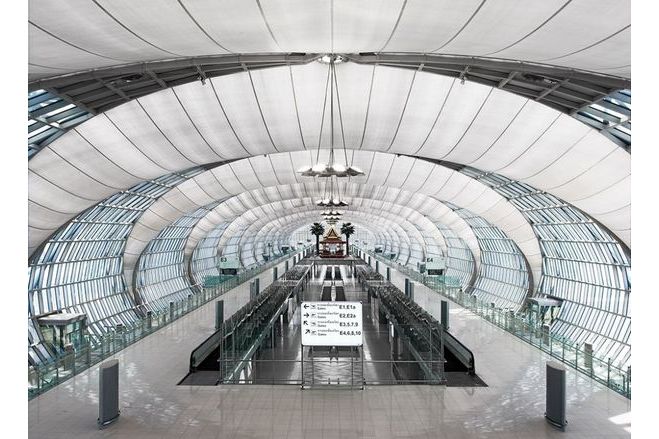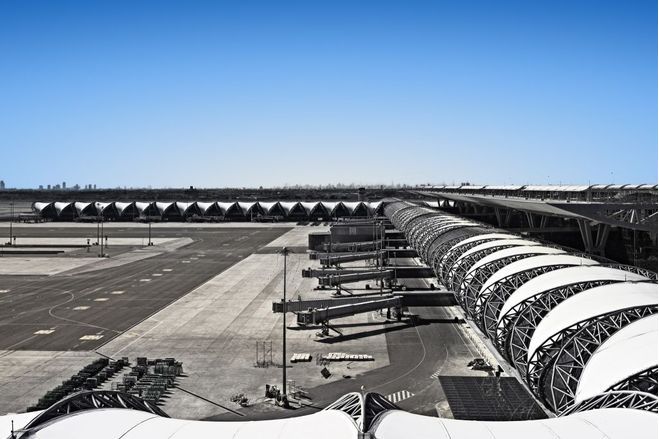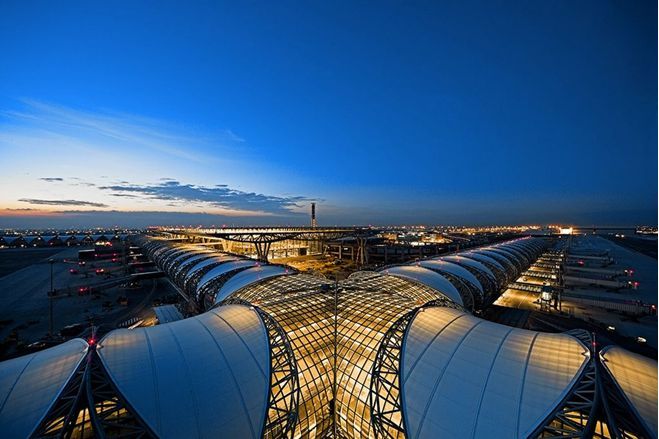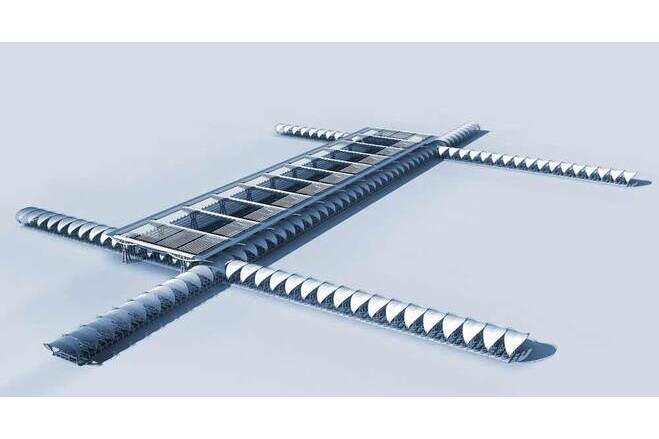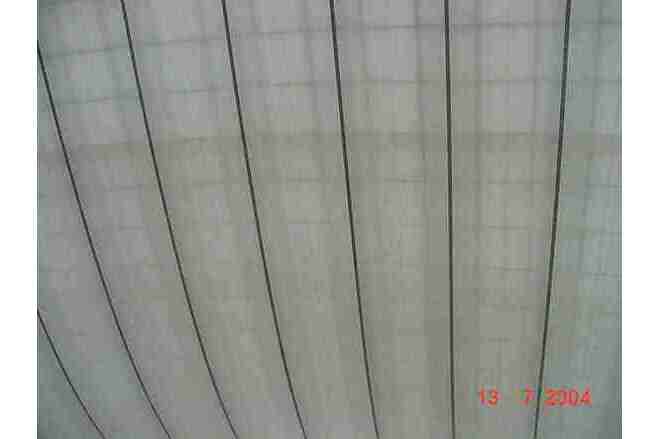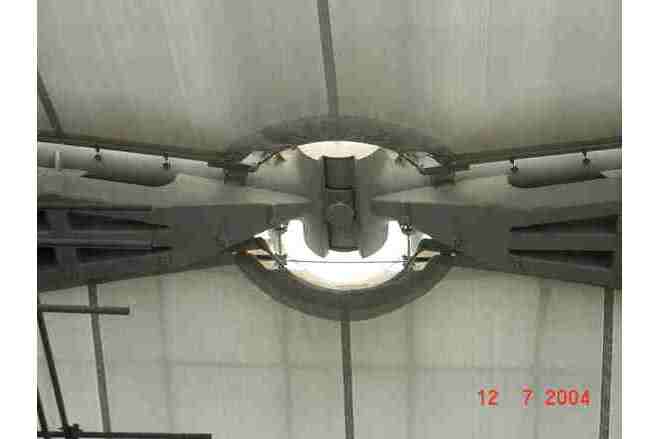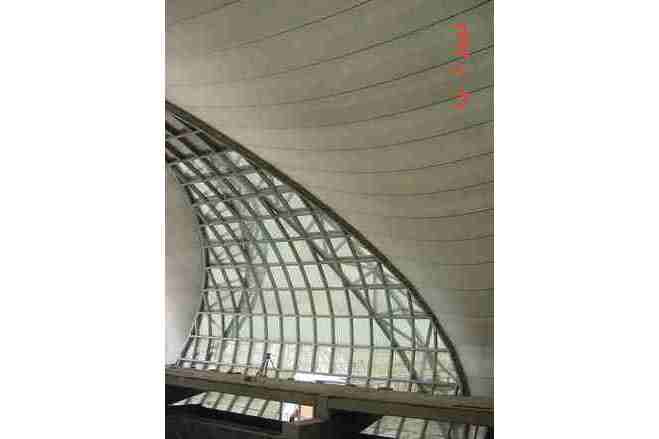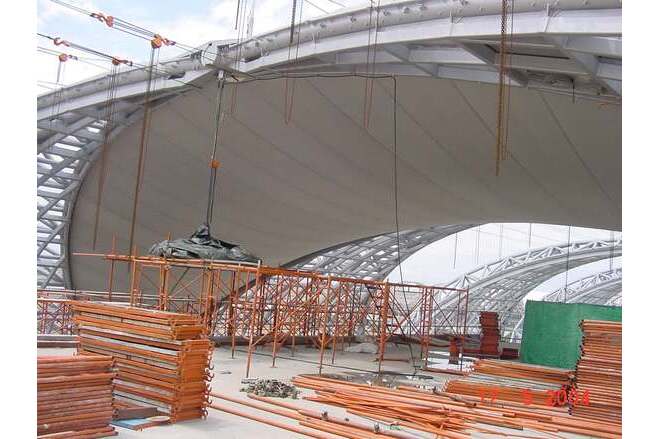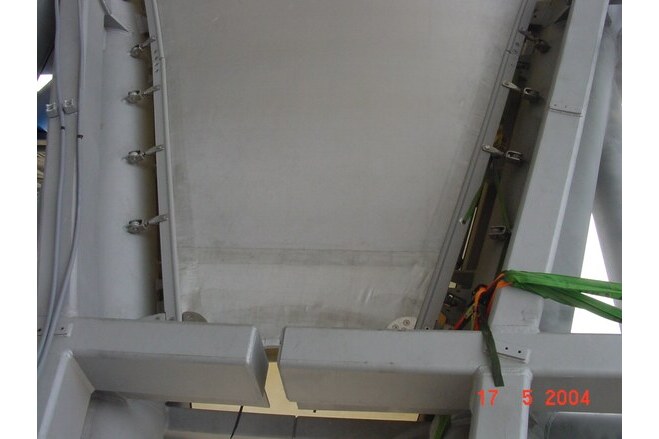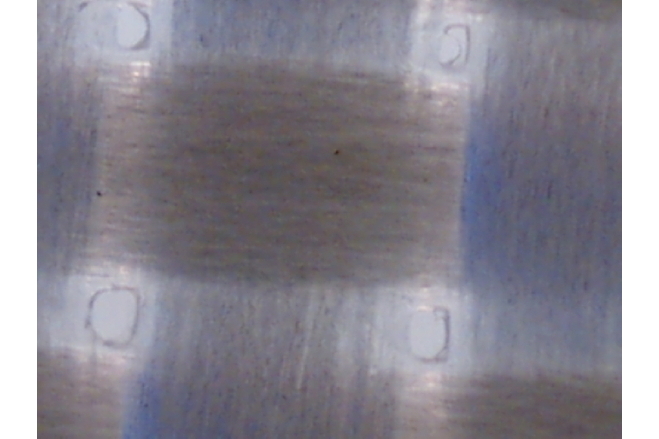New Bangkok International Airport - Inner Liner
General information
-
Home page
https://www.archdaily.com/772509/passenger-terminal-complex-suvarnabhumi-airport-jahn
-
Location address
Bangkok
-
Location country
Thailand
-
Year of construction
2006
-
Function of building
Airports
-
Degree of enclosure
Fully enclosed structure
-
Climatic zone
Tropical - hot and wet all year
-
Number of layers
multi-layer
-
Type of application of the membrane
covering
-
Primary function of the tensile structure
- Daylight gains
- Rain protection
- Space defining elements
- Sun protection
- Thermal insulation
- Wind protection
Description
1. General features of the membrane materials
The Werner Sobek Engineers, the company Transsolar and the Laboratory for Dynamics and Acoustics in Stuttgart have commonly created the concept of the 3–layers membranes, which should guarantee, that (besides the static requirements of the construction) the air-traffic noise emission close to taxiways and runways should be reduced as much as possible. Additionally, it was required to support the energetic concept of the construction with new composites and coating technologies of the membranes.
Besides it was also obligatory, that the Inner Membrane had to be certified in accordance to the flame retardancy classification DIN 4102 A2.
The outer membrane was chosen as the classical and reliable Glass-PTFE composite with high translucency, which has been proofed long term in textile architecture.
The medial layer is fabricated as highly transparent polycarbonate, which is mounted in a steel-grid construction.
The third and from inside visual Inner Liner of this membrane construction was asked to fulfil a composition of new requirements of flame retardancy, acoustic and energetic properties, light transmittance and light reflectance and last but not least with the general appearance of the material.
2. Special features of the Inner Liner
There were no materials in the market available, which could fulfil the complete set up of the requirements. Especially the required low emissivity and the sound absorption established created a too high obstacle for the conventional materials. The company PD Interglas AG took the first task to develop the basic glass-grid – a fabric which would allow an aluminium-coating and could perform a sound absorption and a light transmission by the correct grid-hole-opening-ratio. It was suggested that aluminium-coatings on glass fabrics would perform physically similar to aluminium foils, with a so-called Low Emissivity or heat reflection.
Other than polyester based fabrics, glass weaves as coating and composite bases are able to support the flame retardancy requirement A2. Although aluminium coatings on glass weaves seem not be too complicated in general, but it’s a special problem, to make sure that the aluminisation is embedded and does not lead to an oxidation, what would destroy the reflective property of the aluminium layer in the far Infra-Red.
Because all well-known coating composites like PTFE, PVC or any other plastic materials are not suitable for the task, a brand-new coating polymer became the key element of the product development.
It was a high transparent, non combustible and film-forming polymer, which had been developed out of the group of fluoropolymers. This film-forming ability should allow to reopen the grid-holes of the weave after the coating of the membrane was completed, and therewith enable a high sound absorption.
The weave design and coating composition allowed exceeding the fulfilment of the required noise reduction coefficient of > 0.7 to a new textile achievement value of 0.89.
Interglas AG asked Polymade to demonstrate the feasibility of the task in between 6 weeks after November 2002, because Polymade had developed a coating composite which had become known to the market under the company’s brand SOLAFLON.
After having demonstrated the general feasibility and pre-serial product testing, the complex production logistics of this composite had to be planned and coordinated, especially because a width of 2.2m had to be aluminised in an industrial available vapour deposition process. Other than in conventional slow coating processing for industrial fabrics, the aluminisation is processed on a high-speed level of 300 m/minute. This is a very difficult process to a relatively sensitive glass-grid weave, which requires unusual quality securing steps.
Before receiving the order from the general contractor of NBIA Company ITO, numerous tests had to be performed, mainly aiming to the long-term mechanical strength of the composite. This qualification program was coordinated under the product name A-Tex 2500 Low E and was coordinated between the manufacturer of the glass fabric, the coating company, B&O Hightex and the Laboratory Dr. Blum in Stuttgart. The material logistics for the roofing material such as purchase, appearance control, documentation etc. is executed by OGAWATEC, Tokyo to support the general contractor ITO, Bangkok and the fabricating company B&O Hightex, Riemsting, Germany.
Pure glass-based fabrics without a sufficient polymer coating cannot be used in tailoring and fabrication, because the material is too sensitive.
The process of coating should be carried out asymmetrically, that no oxidation can occur on the aluminium side, without overruling the LOW-E effect by the fluoropolymer coating with an absorption in the far Infra-Red. A stronger coating on the back side should allow an easier handling of the membrane in tailoring, welding and assembly. The required solar reflection of the white side with more than 60% could be guaranteed due to the transparent coating of SOLAFLON.
To fulfil the required optical features of the fabrication in 104 Typical Bays, a suitable technical connection or seam, had to be qualified. The demand of a weld strength, which corresponds to the material strength with 3250N/5cm, could be achieved by the availability of a transparent and compatible welding-aid. The coating material does not lead to losses of the tensile strength of the fabric but improves the glass filament protective embedding. Consequently, it was possible to keep the tensile strength after the micro-perforation of the membrane. As aluminium coating is an energy barrier for the economical RF welding-method - what is generally possible with SOLAFLON - the seams had to be made with a so-called heating bar welding.
3. Fabrication process of the Inner Liner
The required glass-grid-fabric was woven at the PD Interglas weaving factory in Malmerspach/France. Before the fabric roles could be sent to get aluminised, they had to get a SOLAFLON-base coating. Without this base coating it is not possible, to get the required reflection values of the aluminium. The aluminium deposition is processed in three steps up to a thickness of 120nm. After returning the charges of about 20000m2 to 30000m2, the further fluoropolymer-coating and micro-perforation is processed in four different fabrication steps.
The appearance inspection and role recording took place at the weaving factory in Malmerspach/ France. Only there, Interglas AG had an accurate sleeve construction which allows a fold free winding and inspecting of the approximately 600kg heavy roles. Precise protocols allow economical cutting patterns and the optimisation of the tailoring.
4. Demands on the appearance of the Inner Liner
As glass weaving without any defects is not possible, it was a special challenge to reduce the number and the allocation of the defects under the norm of allowed defects for solar-protective screens, falling short from a maximum of 10m per 100 ongoing-meter and mostly to offer 25m middle pieces of the typical Bays for zero defect cutting patterns. A quality improvement program implemented by the participants could guarantee that the defect number could be reduced to approximately 30% of the specified standard. For this reason, it was possible to assemble more than the specified cutting patterns.
Aluminium coated glass-weaves are functioning as a reflector or a mirror and are also sensitive like a mirror. All kind of creases in the weaves appear as dark or bright marks. This caused a special demand to the fabrication, the transportation and the assembly, where each approximately 1100m2 pre-fabricated membrane has to be installed at the construction side in one piece.
Furthermore glass-weaves don’t have any elasticity, therefore a highly specific cutting pattern, a faultless fabrication and frictionless assembly has to be secured. Each avoidable contact towards the optically sensible material could influence the appearance of the membrane. Keeping that in mind and observing the handling instructions, the technical requirements as mechanical strength, LOW-E, transmission and sound absorption will remain unchanged.
When some years ago the designers of the membrane construction specified the Inner Liner, there was no material composite available, which could fulfil the bunch of demands.
This challenge, to introduce a sound absorbing and open aluminised glass fabric with LOW-E and other optical properties was the task which had to be matched.
Without these nearly impossible challenges and the coincidence of visionary demands on the one side and the new SOLAFLON technology on the other side, the breakthrough of this innovative material wouldn’t have happened.
Michael Blum
Walter Duerbaum
Prof. G.K.Brueck
Description of the environmental conditions
Material of the cover
-
Cable-net/Fabric/Hybrid/Foil
Fabric
Main dimensions and form
-
Form single element
Anticlastic
Duration of use
-
Temporary or permanent structure
Permanent
-
Design lifespan in years
31-..
Involved companies
-
Architects
Helmut Jahn
-
Engineers
Werner Sobek
Editor
-
Editor
Marijke M. Mollaert



